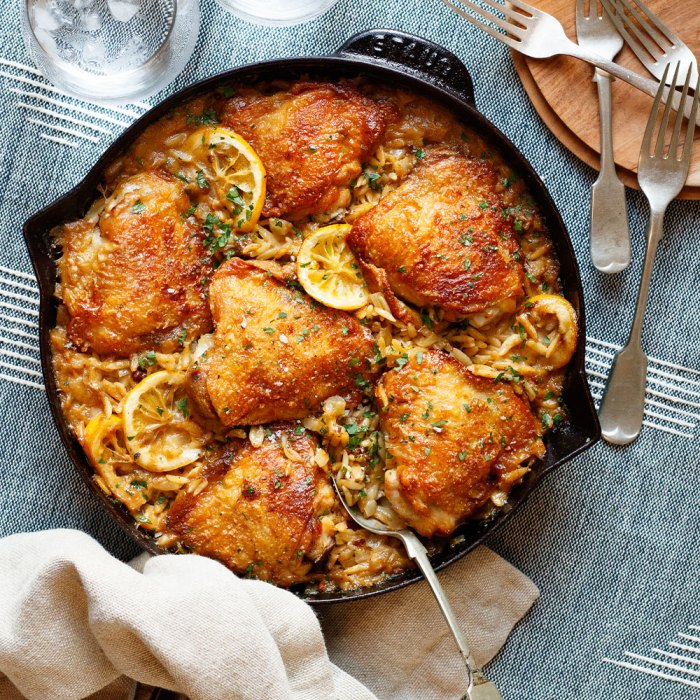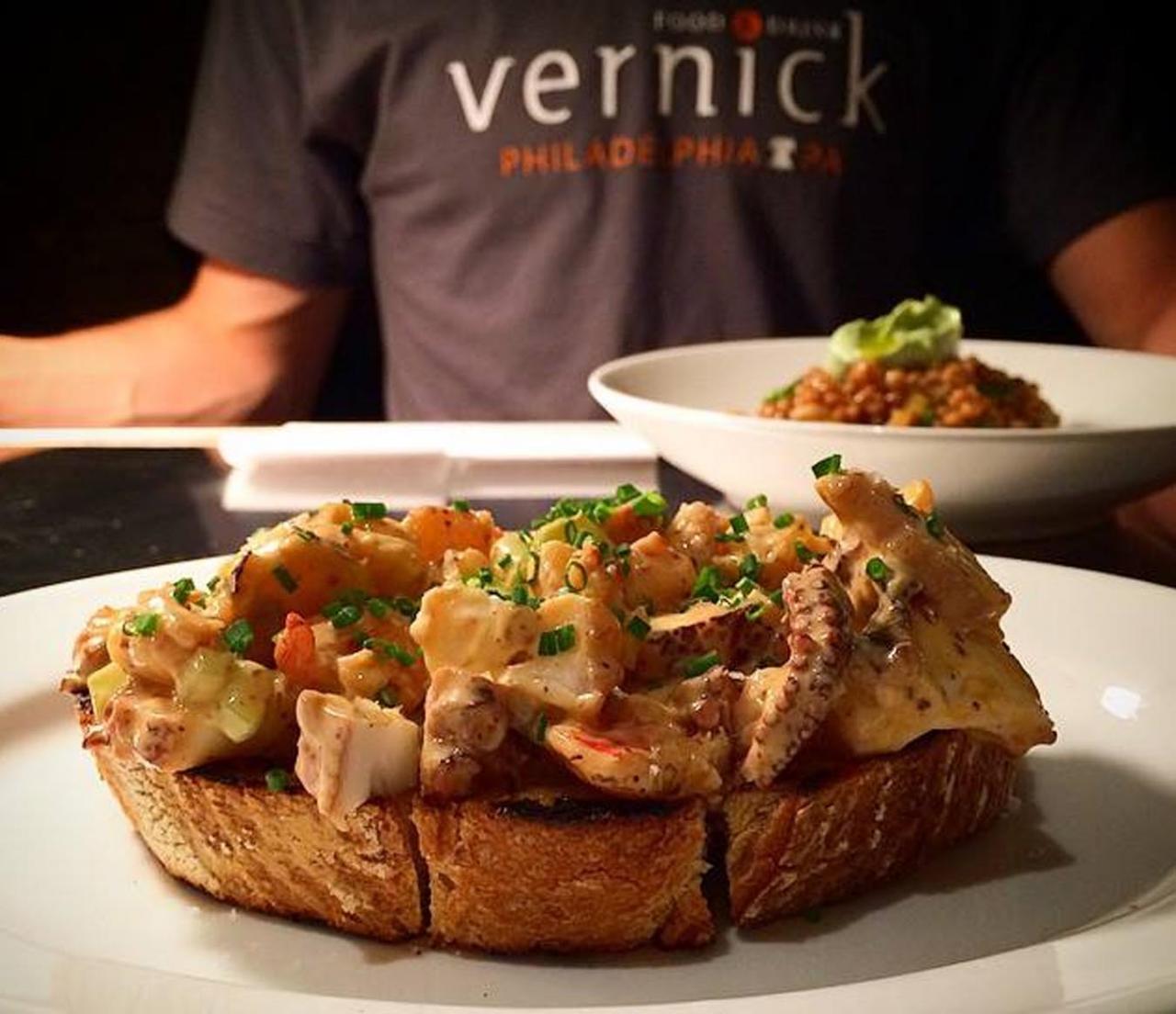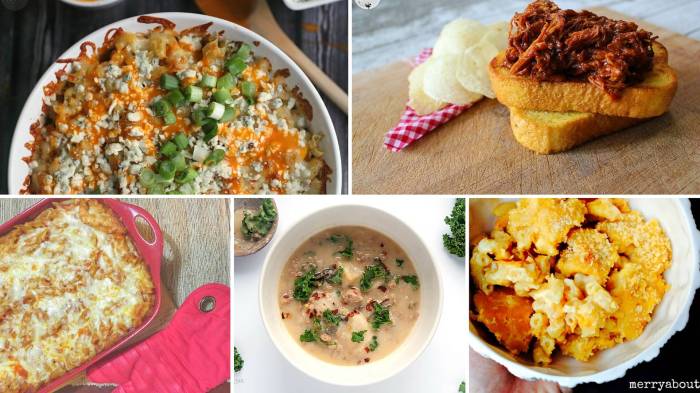One-pot recipes have emerged as a culinary game-changer, offering a convenient and efficient approach to cooking. With their ability to simplify meal preparation and reduce cleanup time, one-pot dishes have become a staple in kitchens worldwide. This comprehensive guide delves into the world of one-pot recipes, exploring their benefits, techniques, and health advantages, providing a roadmap for culinary success.
Definition and Overview

One-pot recipes are a convenient and efficient way to prepare meals using a single cooking vessel, typically a pot or Dutch oven. This cooking method eliminates the need for multiple pans and pots, reducing cleanup and streamlining the cooking process.
The benefits of one-pot cooking extend beyond convenience. By cooking all ingredients in one pot, flavors meld and develop harmoniously, resulting in dishes that are rich and flavorful. Additionally, one-pot cooking often requires less monitoring and stirring, freeing up the cook to attend to other tasks.
Benefits of One-Pot Cooking
- Reduced cleanup
- Streamlined cooking process
- Enhanced flavor development
- Less monitoring and stirring required
Types of One-Pot Recipes
One-pot recipes encompass a diverse range of culinary creations that can be effortlessly prepared in a single cooking vessel. These recipes exhibit remarkable versatility, catering to a wide array of dietary preferences and cooking techniques.
One-pot recipes can be broadly categorized into several distinct types, each possessing unique characteristics and flavors:
Stews
Stews are hearty and flavorful dishes characterized by their slow-cooked nature. They typically consist of meat, vegetables, and a flavorful liquid, such as broth or wine. Stews are simmered for extended periods, allowing the ingredients to meld and develop rich, complex flavors.
- Beef stew
- Chicken stew
- Vegetable stew
Soups
Soups are liquid-based dishes that can range from clear and light to thick and creamy. They often feature a combination of vegetables, meat, and/or pasta. Soups are versatile and can be enjoyed as a light meal or as an accompaniment to other dishes.
- Chicken noodle soup
- Tomato soup
- Creamy mushroom soup
Casseroles
Casseroles are baked dishes typically prepared in a single dish. They often consist of a combination of meat, vegetables, and a starchy ingredient, such as pasta or rice. Casseroles are often topped with cheese or breadcrumbs and baked until golden brown.
One-pot recipes, as the name suggests, are a convenient and time-saving option for beginners in the kitchen. These recipes require minimal preparation and cooking, making them ideal for those new to cooking. If you’re just starting out, Recipes for beginners can provide a great starting point.
With clear instructions and simple ingredients, these recipes will help you build confidence in the kitchen. Once you’ve mastered the basics, you can explore the versatility of one-pot recipes, which can range from hearty stews to quick and easy pasta dishes.
- Shepherd’s pie
- Tuna casserole
- Chicken and rice casserole
Stir-fries
Stir-fries are quick-cooking dishes that involve stir-frying ingredients in a hot wok or skillet. They typically consist of a combination of meat, vegetables, and a flavorful sauce. Stir-fries are known for their vibrant colors and crisp textures.
One-pot recipes offer a convenient and efficient way to prepare delicious meals. Their simplicity and ease of preparation make them ideal for busy individuals seeking quick and tasty recipes. As highlighted in Quick and tasty recipes , one-pot recipes minimize cleanup and maximize flavor, making them a popular choice among home cooks.
These recipes often involve combining all ingredients in a single pot or pan, resulting in a flavorful and satisfying dish that can be enjoyed in minimal time.
- Beef and broccoli stir-fry
- Chicken and vegetable stir-fry
- Shrimp and tofu stir-fry
Ingredients and Preparation
One-pot recipes typically utilize a range of common ingredients, including vegetables, meats, grains, and seasonings. Vegetables such as onions, carrots, celery, and tomatoes provide a flavorful base, while meats like chicken, beef, or pork add protein. Grains such as rice, pasta, or quinoa provide carbohydrates and can be cooked directly in the same pot as the other ingredients. Seasonings such as salt, pepper, herbs, and spices enhance the flavor profile of the dish.
Preparing one-pot meals involves a variety of techniques and methods. Sautéing, browning, and simmering are common techniques used to develop flavors and textures. Sautéing involves cooking ingredients in a small amount of oil over medium heat, while browning involves searing the surface of meats to create a flavorful crust. Simmering involves cooking ingredients in a liquid at a low temperature for an extended period, allowing flavors to meld and tenderize meats.
Ingredients
- Vegetables: Onions, carrots, celery, tomatoes, bell peppers, mushrooms
- Meats: Chicken, beef, pork, fish, seafood
- Grains: Rice, pasta, quinoa, barley
- Seasonings: Salt, pepper, herbs (e.g., basil, oregano, thyme), spices (e.g., paprika, cumin, chili powder)
Preparation Techniques
- Sautéing: Cooking ingredients in a small amount of oil over medium heat
- Browning: Searing the surface of meats to create a flavorful crust
- Simmering: Cooking ingredients in a liquid at a low temperature for an extended period
One-Pot Cooking Appliances

One-pot cooking appliances are specifically designed to simplify the cooking process by combining multiple functions into a single unit. These appliances offer several advantages, including space-saving, easy cleanup, and versatility.
There are several types of one-pot cooking appliances available, each with its own advantages and disadvantages. The most common types include:
Dutch Ovens
- Dutch ovens are large, heavy-bottomed pots with tight-fitting lids. They are made of cast iron or enameled cast iron and can be used on the stovetop or in the oven.
- Dutch ovens are excellent for slow-cooking, braising, and roasting. They retain heat well and distribute it evenly, resulting in tender and flavorful dishes.
- However, Dutch ovens are relatively expensive and heavy. They also require careful seasoning to prevent rust.
Slow Cookers
- Slow cookers are electric appliances that cook food slowly over several hours. They are typically made of ceramic or stoneware and have a removable insert.
- Slow cookers are ideal for preparing soups, stews, and other dishes that require long cooking times. They are also convenient for meal prepping, as you can set them and forget them.
- However, slow cookers are not as versatile as Dutch ovens and cannot be used for tasks such as searing or sautéing.
Instant Pots
- Instant Pots are multi-functional appliances that combine the features of a pressure cooker, slow cooker, and rice cooker. They are typically made of stainless steel and have a variety of cooking functions.
- Instant Pots are very versatile and can be used to prepare a wide range of dishes, from soups and stews to rice and pasta.
- However, Instant Pots can be more expensive than other one-pot cooking appliances and require some learning to use.
Time-Saving Tips
In today’s fast-paced world, meal preparation often takes a backseat due to time constraints. One-pot recipes offer a convenient solution, but maximizing their efficiency is crucial. This section presents time-saving tips to streamline the preparation of one-pot meals, including meal prepping and batch cooking strategies.
Meal prepping involves planning and preparing meals in advance, typically on weekends or evenings with more free time. This strategy allows for efficient weekday cooking, as ingredients are pre-cut, marinated, or cooked, saving time during the week.
Batch Cooking
Batch cooking involves preparing larger quantities of food in one go, which can be stored and used for multiple meals throughout the week. This method is particularly useful for dishes that require longer cooking times, such as soups, stews, or casseroles. By cooking a larger batch, you can save time and effort on subsequent days when you only need to reheat and serve.
Recipes: One-pot Recipes
One-pot recipes offer a convenient and versatile solution for creating delicious and nutritious meals. They can be adapted to suit a variety of cuisines and dietary preferences, making them a popular choice for home cooks.
The table below provides a selection of one-pot recipes with varying ingredients, serving sizes, and cooking times. Each recipe has been carefully curated to showcase the diversity and practicality of one-pot cooking.
Cuisines and Dietary Preferences
| Recipe | Cuisine | Dietary Preference | Ingredients | Serves | Cooking Time |
|---|---|---|---|---|---|
| One-Pot Chicken and Rice | American | Gluten-free, dairy-free | Chicken, rice, vegetables, broth | 4 | 30 minutes |
| One-Pot Pasta with Tomato Sauce | Italian | Vegetarian | Pasta, tomato sauce, vegetables, herbs | 4 | 20 minutes |
| One-Pot Chili | Mexican | Gluten-free, dairy-free | Ground beef, beans, vegetables, spices | 6 | 45 minutes |
| One-Pot Salmon with Quinoa | Mediterranean | Gluten-free, dairy-free | Salmon, quinoa, vegetables, lemon | 4 | 25 minutes |
| One-Pot Vegetarian Curry | Indian | Vegan, gluten-free | Vegetables, lentils, spices, coconut milk | 4 | 30 minutes |
Health Benefits
One-pot cooking offers several potential health benefits, making it an appealing choice for individuals seeking a healthier lifestyle.
One of the key advantages is the reduced cooking time. By combining multiple ingredients in a single pot, one-pot recipes significantly shorten the cooking process, which helps preserve the nutrients in the food. This is particularly important for preserving vitamins and minerals, which are often lost during prolonged cooking.
Furthermore, one-pot recipes promote portion control. The act of cooking all ingredients in a single pot helps individuals visualize the amount of food they are consuming, reducing the risk of overeating. This can be especially beneficial for those trying to maintain a healthy weight or manage calorie intake.
Balanced Diet
One-pot recipes can contribute to a balanced diet by incorporating a variety of food groups into a single dish. For instance, a one-pot meal that includes lean protein, whole grains, and vegetables provides a comprehensive range of essential nutrients, including carbohydrates, protein, fiber, vitamins, and minerals. By combining different food groups, one-pot recipes make it easier to meet daily nutrient requirements and maintain a healthy, well-rounded diet.
Presentation and Garnishes
The presentation of one-pot dishes plays a crucial role in enhancing their appeal. Arranging the ingredients in a visually pleasing manner can make the dish more inviting and appetizing. Garnishes add an extra touch of color, texture, and flavor to the dish.
Tips for Appealing Presentation
- Arrange the main ingredients prominently in the center of the pot or plate.
- Create height by layering ingredients or using ramekins to elevate certain elements.
- Use contrasting colors to make the dish more visually interesting.
li>Consider the shape and size of the ingredients when arranging them.
Garnishes
Garnishes serve both aesthetic and functional purposes. They add color, texture, and flavor to the dish. Common garnishes include:
- Fresh herbs (e.g., parsley, cilantro, basil)
- Citrus zest or juice
- Nuts and seeds
- Crispy fried onions or shallots
- Drizzle of olive oil or balsamic glaze
When using garnishes, consider the following tips:
- Use garnishes that complement the flavors of the dish.
- Add garnishes just before serving to ensure freshness.
- Use a light hand to avoid overpowering the dish.
Cleaning and Storage
Cleaning and storing one-pot dishes requires proper techniques to ensure hygiene and preserve the quality of leftovers. By following best practices, you can maintain the freshness and flavor of your meals.
After cooking, allow the dish to cool slightly before cleaning. This prevents thermal shock and makes handling the pot safer. Use a non-abrasive sponge or brush to gently remove food particles. Avoid using harsh detergents or steel wool, as these can damage the pot’s surface.
Preserving Leftovers, One-pot recipes
To preserve leftovers effectively, store them in airtight containers in the refrigerator. This prevents spoilage by limiting air exposure. Label the containers with the date and contents for easy identification.
Reheating Leftovers
Reheat leftovers thoroughly to ensure food safety. Use the microwave, stovetop, or oven to heat the dish until it reaches an internal temperature of 165°F (74°C). Stir or rotate the food during reheating to distribute heat evenly.
Last Recap
In conclusion, one-pot recipes offer a myriad of benefits, making them an indispensable tool for busy individuals, culinary enthusiasts, and health-conscious diners alike. Their versatility, ease of preparation, and nutritional value make them an excellent choice for a wide range of cooking scenarios. Whether you’re a novice cook or a seasoned chef, embracing one-pot cooking will elevate your culinary repertoire and transform mealtimes into effortless and enjoyable experiences.
Helpful Answers
Are one-pot recipes suitable for all dietary preferences?
Yes, one-pot recipes can be adapted to accommodate various dietary preferences. By carefully selecting ingredients, it’s possible to create gluten-free, vegan, vegetarian, and low-carb one-pot dishes.
Can one-pot recipes be prepared in advance?
Yes, many one-pot recipes can be prepared in advance. Meal prepping and batch cooking techniques allow you to prepare meals ahead of time, saving time during busy weekdays.
What are the advantages of using a Dutch oven for one-pot cooking?
Dutch ovens are ideal for one-pot cooking due to their versatility and ability to distribute heat evenly. They can be used on the stovetop or in the oven, making them suitable for a wide range of recipes.


